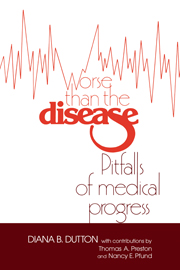Book contents
- Frontmatter
- Contents
- List of contributors
- Preface
- Acknowledgements
- List of abbreviations
- Part I Overview
- Part II Four case studies
- 3 DES and the elusive goal of drug safety
- 4 The artificial heart
- 5 The swine flu immunization program
- 6 Genetic engineering: science and social responsibility
- Part III Lessons, questions, and challenges
- Notes
- Index
5 - The swine flu immunization program
Published online by Cambridge University Press: 05 May 2010
- Frontmatter
- Contents
- List of contributors
- Preface
- Acknowledgements
- List of abbreviations
- Part I Overview
- Part II Four case studies
- 3 DES and the elusive goal of drug safety
- 4 The artificial heart
- 5 The swine flu immunization program
- 6 Genetic engineering: science and social responsibility
- Part III Lessons, questions, and challenges
- Notes
- Index
Summary
Sweet peace be his, who wipes the weeping eye, And dries the tear of sobbing misery! Still higher joys shall to his bosom flow, Who saves the eye from tears, the heart from woe! – A far, far greater honor he secures, Who stops the coming ill, than he who cures.
– Valentine Seaman to Samuel Scofield, letter dated August 15, 1809, in Samuel Scofield, A Practical Treatise on Vaccinia or Cowpock (New York: Southwick and Pelsue, 1810), p. v.When Private David Lewis, an Army recruit, reported for sick call at Fort Dix, New Jersey, in February 1976, complaining of mild, flulike symptoms, no one dreamed he would be dead within hours. Nor would anyone have imagined that his death would open an unprecedented episode in American public health: a federally funded campaign to immunize every man, woman, and child in the United States against a feared “killer” epidemic of swine flu.
At first the choice seemed clear: If the epidemic came, the nation would be protected; if it did not, the program would still have been a prudent investment. “Dollars for lives” became the byword of federal officials. Yet almost nothing seemed to go right. The program was mired in controversy from the outset and, beset with an unending string of problems, it fell farther and farther behind schedule. And the epidemic never came. Moreover, despite repeated assurance of safety, swine flu shots were later linked to Guillain—Barré syndrome, a paralyzing and sometimes fatal neurological condition. Over a decade later, lawsuits over alleged vaccine–induced injuries were still underway.
- Type
- Chapter
- Information
- Worse than the DiseasePitfalls of Medical Progress, pp. 127 - 173Publisher: Cambridge University PressPrint publication year: 1988
- 2
- Cited by



